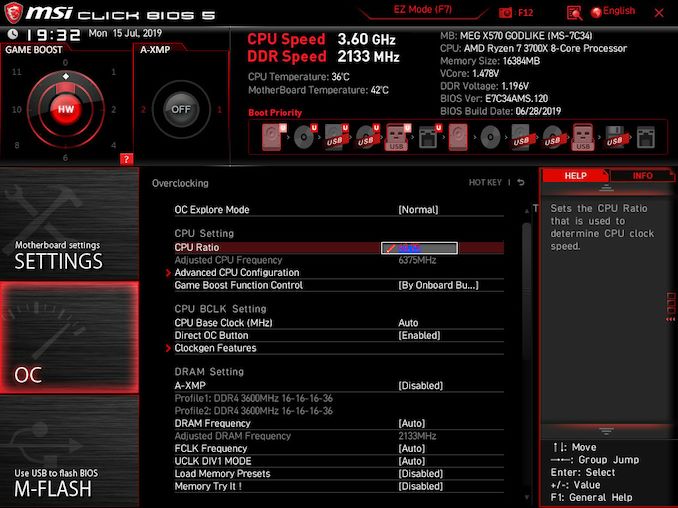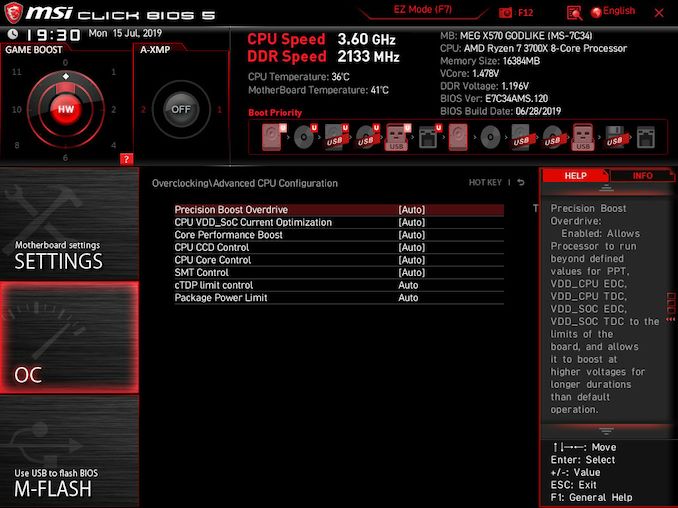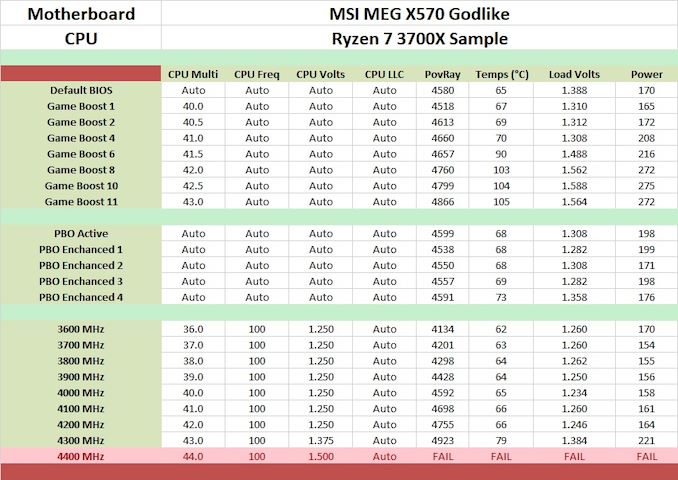The MSI MEG X570 Godlike Motherboard Review: Thor's Flagship
by Gavin Bonshor on August 28, 2019 12:00 PM EST- Posted in
- Motherboards
- AMD
- MSI
- 10G Ethernet
- Ryzen
- PCIe 4.0
- Ryzen 3000
- X570
- X570 Godlike
- MEG
Overclocking Ryzen 3000
Experience with the MSI MEG X570 Godlike
Overclocking with the Ryzen 3000 series hasn't exactly titillated users since its launch with there not being much headroom available. The biggest issue with this boils down to all-core overclocks being limited by the worst core of the chip. and the new 7 nm processors running quite warm. To get the best experience and results with the Ryzen 3000, users with good quality AIOs and custom water cooling yields the best outcome, and even with voltages of 1.375 V, these chips can run a little too warm for comfort.
The MSI Click BIOS 5 firmware is familiar to us and throughout the different chipsets including X399, X470, and Z390, the MSI MEG X570 Godlike uses the same design layout and setup. Within the OC section of the firmware, users can alter important settings such as the CPU ratio which can be changed in steps of 0.25 MHz, with relevant settings including CPU VCore, CPU Base Clock, and even FCLK frequency. Deeper into the firmware is settings to set the load line calibration (LLC) to a more aggressive or liberal profile, as well as all the Precision Boost Overdrive (PBO) settings.
The three main settings that PBO works from include package power tracking (PPT), thermal design current (TDC), and the electrical design current (EDC). All three of these can be set within the firmware under the advanced section of the Precision Boost Overdrive menu, although MSI has included four different PBO profiles for users to select from. The higher the setting, the higher the thermal and power draw will be, and it may not necessarily matter if a sub-par cooler is installed; it's noted that Ryzen 3000 processors work better when they are cooler.
There are seven different MSI Game Boost profiles to select from and users can access them via the dial at the bottom of the board, or through the firmware itself. The Game Boost profiles within the firmware can be accessed through the dial in the top left-hand corner. These profiles range from 4.0 GHz through to 4.3 GHz, and we've tested each of them below.
Overclocking Methodology
Our standard overclocking methodology is as follows. We select the automatic overclock options and test for stability with POV-Ray and OCCT to simulate high-end workloads. These stability tests aim to catch any immediate causes for memory or CPU errors.
For manual overclocks, based on the information gathered from the previous testing, starts off at a nominal voltage and CPU multiplier, and the multiplier is increased until the stability tests are failed. The CPU voltage is increased gradually until the stability tests are passed, and the process repeated until the motherboard reduces the multiplier automatically (due to safety protocol) or the CPU temperature reaches a stupidly high level (105ºC+). Our testbed is not in a case, which should push overclocks higher with fresher (cooler) air.
Overclocking Results
As it currently stands, MSI's Game Boost overclocking profiles need quite a bit of refinement, something they have informed us that these will be rectified with a new firmware revision; we will test this when we receive the board back from MSI. The issue with these is CPU VCore, or in a nutshell, too much of it which cross the board into the unsafe territory of the Ryzen 3000 processors safety limits; both in CPU VCore and in temperature. When we activated PBO and MSI's preset profiles for this, it didn't make much of an impact over the stock settings, which seems to be a reoccurring issue so far across the range of models we have tested so far.
Manually overclocking the MSI MEG X570 Godlike proved very fruitful and we managed to hit what seems to be the limits of our Ryzen 7 3700X testbed CPU with an overclock of 4.3 GHz all-cores with a CPU VCore of 1.35 V, which seems to be the brick wall for our processor. Even with a CPU VCore of 1.50 V, we couldn't get 4.4 GHz to remain stable when any kind of semi-intensive load was placed on the processor, although we did manage to boot into Windows 10 without fanfare with these settings. The performance wasn't throttled in POV-Ray throughout each of the frequencies tested and once the temperature limit of 110ºC is exceeded, the system will safely shut down. From 3.6 to 4.2 GHz, we managed to do this with a set CPU VCore of 1.250 V which did fluctuate slightly under load under the auto LLC setting. It is safe to say that the MSI MEG X570 Godlike doesn't have a VDroop issue and even at 4.3 GHz, a set CPU VCore of 1.375 resulted in a maximum load voltage of 1.384 V which isn't too far off the mark.













116 Comments
View All Comments
TheinsanegamerN - Thursday, August 29, 2019 - link
Have yo even heard the fans in my system? They are near silent, not high pitched whiny tenny tiny fans from 1998.Screw tiny fans, passive heatsink all the way.
WaltC - Thursday, August 29, 2019 - link
There are no tiny, 1998 fans anywhere on my Aorus Master x570, I'll have you know....;) Who is still selling them? (No one I know!) My PCH fan is so quiet I had to check to make sure it was still running.ballsystemlord - Thursday, August 29, 2019 - link
Oh, I have such a fan. I bought it just in case I needed to cool something really tiny. Not that I've used it yet though...Sivar - Friday, August 30, 2019 - link
I have had too many tiny fans die, get loud over time, or get clogged up in their own dust collection.I understand that this chipset uses far more power than those from Intel, but I don't care -- fanless or no purchase.
Thunder 57 - Wednesday, August 28, 2019 - link
Ugh, another board with "gaming" plastered all over it.croc - Wednesday, August 28, 2019 - link
Noticing the trend? Slap 'Game' or Gamer' or 'Gaming' on a product and mark it up by 80%. The 'market' must think we self-builders are either very dumb or very rich... (And I guess they must be right because this crap DOES sell...)Thunder 57 - Thursday, August 29, 2019 - link
To be honest, I own a "gaming" mobo. I wanted something with better VRM's than the cheaper, standard boards, but didn't want to pay too much for a more professional board like a Taichi. That basically meant an "REG Gamer Brahh" board. At least the RGB can be turned off.WaltC - Thursday, August 29, 2019 - link
This board is $700, uses voltage doublers, has a creaky and slow UEFI bios, provides you with a add-in 10Gb Networking card which, if your home network runs at 1Gb, will operate at 1Gb...;) Nope, I'd buy something like that separately if I should ever need one! Did anyone check to see if it makes Pizza?StrangerGuy - Friday, August 30, 2019 - link
Their B450 Tomahawk with the useless DVI port wasting so much I/O real estate instead of putting in more USB or HDMI/DP ports was bad enough, but this $700 board really takes the cake in turning up the rear I/O dumbness.PeachNCream - Thursday, August 29, 2019 - link
It works very well. Adding RGB lighting, sticking the word "gamer" on it someplace, and claiming it has magically better voltage regulation for that extra 2.1% more overclock you're going to get (which has a lot more to do with the CPU you end up purchasing) works to hock garbage hardware to stupid people that mindlessly chase that extra one frame they get every second. I say if it works and it drives the economy, then companies should go for it so I can collect dividends when I buy shares with my cash instead of mindlessly trying to impress random people I meet by dribbling out meaningless specs and posting "battlestation" pictures on Reddit.